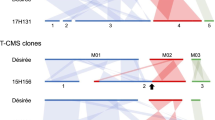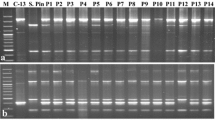Abstract
Tetrad sterility, in which only clumps of four premature pollen grains are released from anthers, has been observed in some modern potato cultivars. It is a form of cytoplasmic male sterility caused by the cytoplasm derived from the Mexican tetraploid species Solanum stoloniferum Schltdl. & Bouché., an important source of resistance to Potato virus Y in potato breeding. However, since S. stoloniferum is highly polymorphic, the source of tetrad-sterility-causing cytoplasm is unknown among diverse S. stoloniferum accessions. In this study, we directly crossed 24 S. stoloniferum accessions with pollen from 4x S. tuberosum and obtained 39 hybrids from 12 accessions. Nineteen hybrids from six accessions showed tetrad sterility, with either D/γ- or W/γ-type cytoplasm, and were triploid, tetraploid, or hexaploid. The W/γ-type cytoplasm was not necessarily associated with tetrad sterility. Sequence comparisons of 17 mitochondrial genes and their intergenic regions revealed a length polymorphism in the intergenic region between rpl5 and rps10, in which an amplified band of 859 bp was associated with tetrad sterility. This specific cytoplasm causing tetrad sterility is named TSCsto. The 859-bp band will be a useful diagnostic marker for identifying TSCsto in potato breeding.





Similar content being viewed by others
References
Abdalla MMF, Hermsen JGTh (1971) The plasmon-genic basis of pollen lobedness and tetrad sterility in Solanum verrucosum hybrids and duplicate linkage groups. Genetica 42:261–270
Abdalla MMF, Hermsen JGTh (1972) Plasmons and male sterility types in Solanum verrucosum and its interspecific hybrid derivatives. Euphytica 21:209–220
Anisimova IN, Gavrilenko TA (2017) Cytoplasmic male sterility and prospects for its utilization in potato breeding, genetic studies and hybrid seed production. Russ J Genet Appl Res 7:721–735
Bamberg J, Fernamdez C, del Rio A (2006) A new wild potato mutant in Solanum stoloniferum Schltdl. lacking purple pigment. Am J Potato Res 83:437–445
Bentolila S, Stefanov S (2012) A reevaluation of rice mitochondrial evolution based on the complete sequence of male-fertile and male-sterile mitochondrial genomes. Plant Physiol 158:996–1017
Brown C (1984) Tetrad sterility: a cytoplasmic-genic male sterility attractive to bumble bees. In: Winger FA, Stockli A (eds.) Abstracts of the conference papers of the 9th Triennial conference of the European association for potato research, Interlaken, Switzerland, pp 101–102
Buck RW Jr (1960) Male sterility in interspecific hybrids of Solanum. J Hered 51:13–14
Budar F, Touzet P, De Paepe R (2003) The nucleo-mitochondrial conflict in cytoplasmic male sterilities revisited. Genetica 117:3–16
Clulow SA, Wilkinson MJ, Waugh R, Baird E, DeMaine MJ, Powell W (1991) Cytological and molecular observations on Solanum phureja-induced dihaploid potatoes. Theor Appl Genet 82:545–551
Cockerham G (1943) Potato breeding for virus resistance. Ann Appl Biol 30:105–108
Dawson J, Wilson ZA, Aarts MGM, Braithwaite AF, Briarty LG, Mulligan NJ (1993) Microspore and pollen development in six male-sterile mutants of Arabidopsis thaliana. Can J Bot 71:629–638
Feingold S, Lloyd J, Norero N, Bonierbale MW, Lorenzen J (2005) Mapping and characterization of new EST-derived microsatellites for potato (Solanum tuberosum L.). Theor Appl Genet 111:456–466
Flis B, Hennig J, Strzelczyk-Żyta D, Gebhardt C, Marczewski W (2005) The Ry-fsto gene from Solanum stoloniferum for extreme resistance to Potato virus Y maps to potato chromosome XII and is diagnosed by PCR marker GP122718 in PVY resistant potato cultivars. Mol Breed 15:95–101
Gavrilenko TA, Klimenko NS, Alpatieva NV, Kostina LI, Lebedeva VA, Evdokimova ZZ, Apalikova OV, Novikova LY, Antonova OYu (2019) Cytoplasmic genetic diversity of potato varieties bred in Russia and FSU countries. Vavilov J Genet Breed 23:753–764
Grun P, Aubertin M, Radlow A (1962) Multiple differentiation of plasmons of diploid species of Solanum. Genetics 47:1321–1333
Grun P, Ochoa C, Capage D (1977) Evolution of cytoplasmic factors in tetraploid cultivated potatoes (Solanaceae). Amer J Bot 64:412–420
Hanson MR, Bentolila S (2004) Interactions of mitochondrial and nuclear genes that affect male gametophyte development. Plant Cell 16:S154–S169
Hawkes JG (1990) The potato: evolution, biodiversity and genetic resources. Belhaven Press, London
Hosaka K, Hanneman RE Jr (1994) Random amplified polymorphic DNA markers detected in a segregating hybrid population of Solanum chacoense × S. phureja. Jpn J Genet 69:53–66
Hosaka K, Sanetomo R (2012) Development of a rapid identification method for potato cytoplasm and its use for evaluating Japanese collections. Theor Appl Genet 125:1237–1251
Irikura Y (1976) Cytogenetic studies on the haploid plants of tuber-bearing Solanum species. 2. Cytological investigations on haploid plants and interspecific hybrids by utilizing haploidy (in Japanese). Res Bull Hokkaido Natl Agric Exp Stn 115:1–80
Iwanaga M, Ortiz R, Cipar MS, Peloquin SJ (1991) A restorer gene for genetic-cytoplasmic male sterility in cultivated potatoes. Am Potato J 68:19–28
Jansky SH, Charkowski AO, Douches DS, Gusmini G, Richael C, Bethke PC, Spooner DM, Novy RG, De Jong H, De Jong WS, Bamberg JB, Thompson AL, Bizimungu B, Holm DG, Brown CR, Haynes KG, Sathuvalli VR, Veilleux RE, Miller JC Jr, Bradeen JM, Jiang J (2016) Reinventing potato as diploid inbred line-based crop. Crop Sci 56:1412–1422
Johnston SA, den Nijs TPM, Peloquin SJ, Hanneman RE Jr (1980) The significance of genetic balance to endosperm development in interspecific crosses. Theor Appl Genet 57:5–9
Kaul MLH (1988) Male sterility in higher plants. Springer, Berlin
Lindhout P, Meijer D, Schotte T, Hutten RCB, Visser RGF, van Eck HJ (2011) Towards F1 hybrid seed potato breeding. Potato Res 54:301–312
Lössl A, Adler N, Horn R, Frei U, Wenzel G (1999) Chondriome-type characterization of potato: mt α, β, γ, δ, ε and novel plastid-mitochondrial configurations in somatic hybrids. Theor Appl Genet 99:1–10
Lössl A, Götz M, Braun A, Wenzel G (2000) Molecular markers for cytoplasm in potato: male sterility and contribution of different plastid-mitochondrial configurations to starch production. Euphytica 116:221–230
Matsubayashi M (1955) Studies on the species differentiation in the section Tuberarium of Solanum. III. Behavior of meiotic chromosomes in F1 hybrid between S. longipedicellatum and S. schickii, in relation to its parent species. Sci Rept Hyogo Univ Agr 2:25–31
Matsubayashi M (1991) Phylogenetic relationships in the potato and its related species. In: Tsuchiya T, Gupta PK (eds) Chromosome engineering in plants: Genetics, breeding, evolution Part B. Elsevier, Amsterdam, pp 93–118
Mihovilovich E, Sanetomo R, Hosaka K, Ordoñez B, Aponte M, Bonierbale M (2015) Cytoplasmic diversity in potato breeding: case study from the International Potato Center. Mol Breed 35:13
Milbourne D, Meyer RC, Collins AJ, Ramsay LD, Gebhardt C, Waugh R (1998) Isolation, characterisation and mapping of simple sequence repeat loci in potato. Mol Gen Genet 259:233–245
Mori K, Sakamoto Y, Mukojima N, Tamiya S, Nakao T, Ishii T, Hosaka K (2011) Development of a multiplex PCR method for simultaneous detection of diagnostic DNA markers of five disease and pest resistance genes in potato. Euphytica 180:347–355
Ortiz R, Iwanaga M, Peloquin S (1993) Male sterility and 2n pollen in 4x progenies derived from 4x × 2x and 4x × 4x crosses in potatoes. Potato Res 36:227–236
Pendinen G, Gavrilenko T, Jiang J, Spooner DM (2008) Allopolyploid speciation of the Mexican tetraploid potato species Solanum stoloniferum and S. hjertingii revealed by genomic in situ hybridization. Genome 51:714–720
Plaisted RL, Hoopes RW (1989) The past record and future prospects for the use of exotic potato germplasm. Am Potato J 66:603–627
Polyukhovich YV, Makhan’ko OV, Savchuk AV, Voronkova EV, Yermishin AP (2010) Development of bridge lines for overcoming interspecific incompatibility in potatoes (in Russian). Proc Nat Acad Sci Belarus 2:51–58
Potato Genome Sequencing Consortium (2011) Genome sequence and analysis of the tuber crop potato. Nature 475:189–195
Rhee SY, Somerville CR (1998) Tetrad pollen formation in quartet mutants of Arabidopsis thaliana is associated with persistence of pectic polysaccharides of the pollen mother cell wall. Plant J 15:79–88
Rodríguez F, Spooner DM (2009) Nitrate reductase phylogeny of potato (Solanum sect. Petota) genomes with emphasis on the origins of the polyploid species. Syst Bot 34:207–219
Ross H (1986) Potato breeding-problems and perspectives. Verlag Paul Parey, Berlin
Sanders PM, Anhthu QB, Weterings K, McIntire KN, Hsu Y, Lee PY, Troung MT, Beals TP, Goldberg RB (1999) Anther developmental defects in Arabidopsis thaliana male-sterile mutants. Sex Plant Reprod 11:297–322
Sanetomo R, Gebhardt C (2015) Cytoplasmic genome types of European potatoes and their effects on complex agronomic traits. BMC Plant Biol 15:162
Sanetomo R, Hosaka K (2013) A recombination-derived mitochondrial genome retained stoichiometrically only among Solanum verrucosum Schltdl. and Mexican polyploid wild potato species. Genet Resour Crop Evol 60:2391–2404
Schnable PS, Wise RP (1998) The molecular basis of cytoplasmic male sterility and fertility restoration. Trends Plant Sci 3:175–180
Scott R, Hodge R, Paul W, Draper J (1991) The molecular biology of anther differentiation. Plant Sci 80:167–191
Scotti N, Maréchal-Drouard L, Cardi T (2004) The rpl5-rps14 mitochondrial region: a hot spot for DNA rearrangements in Solanum spp. somatic hybrids. Curr Genet 45:378–382
Shishova M, Puzanskiy R, Gavrilova O, Kurbanniazov S, Demchenko K, Yemelyanov V, Pendinen G, Shavarda A, Gavrilenko T (2019) Metabolic alterations in male-sterile potato as compared to male-fertile. Metabolites 9:24
Song YS, Schwarzfischer A (2008) Development of STS markers for selection of extreme resistance (Rysto) to PVY and maternal pedigree analysis of extremely resistant cultivars. Am J Pot Res 85:159–170
Spooner DM, Castillo RT (1997) Reexamination of series relationships of South American wild potatoes (Solanaceae: Solanum sect. Petota): evidence from chloroplast DNA restriction site variation. Am J Bot 84:671–685
Spooner DM, van den Berg RG, Rodríguez A, Bamberg J, Hijmans RJ, Cabrera SIL (2004) Wild potatoes (Solanum section Petota; Solanaceae) of North and Central America. Systematic Botany Monographs, vol 68. The American Society of Plant Taxonomists, Ann Arbor
Taylor PE, Glover JA, Lavithis M, Craig S, Singh MB, Knox RB, Dennis ES, Chaudhury AM (1998) Genetic control of male fertility in Arabidopsis thaliana: structural analyses of postmeiotic developmental mutants. Planta 205:492–505
Voronkova EV, Lisovskaya VM, Yermishin AP (2007) Diploid hybrids between allotetraploid wild potato species Solanum acaule Bitt., S. stoloniferum Schltdl. and dihaploids of S. tuberosum L (in Russian). Russian J Genet 43:882–888
Vos PG, Uitdewilligen JGAML, Voorrips RE, Visser RGF, van Eck HJ (2015) Development and analysis of a 20K SNP array for potato (Solanum tuberosum): an insight into the breeding history. Theor Appl Genet 128:2387–2401
Wilson ZA, Morroll SM, Dawson J, Swarup R, Tighe PJ (2001) The Arabidopsis MALE STERILITY 1 (MS1) gene is a transcriptional regulator of male gametogenesis, with homology to the PHD-finger family of transcription factors. Plant J 28:27–39
Yamagishi H, Bhat SR (2014) Cytoplasmic male sterility in Brassicaceae crops. Breed Sci 64:38–47
Yermishin AP, Levy AV, Voronkova EV, Polyukhovich YuV, Ageeva AS (2017) Overcoming unilateral incompatibility in crosses with wild allotetraploid potato species Solanum stoloniferum Schldtl. & Bouchet. Euphytica 213:249
Zhu GQ, Tan XL, Zhao Y, Zi QY, Zheng YZ, Yan CQ, He TT, Sun CH, Huang DJ, Tan YL, Xu J, Wen JC (2015) Relationship between CMS-specific mitochondrial structures and pollen abortive phenotype in rice CMS lines. Euphytica 206:149–158
Acknowledgements
We thank Dr. K. Hosaka, Obihiro University of Agriculture and Veterinary Medicine, for improving the manuscript and W. Takenaka for technical assistance. The research was financially supported partly by a JSPS Grant-in-Aid for Scientific Research for Young Scientists (Grant Number JP19K15813) and by Calbee Inc., the Hokkaido Potato Growers Association, Kewpie Corp., KENKO Mayonnaise Co., Ltd., and the Japan Snack Cereal Foods Association.
Author information
Authors and Affiliations
Contributions
AN and RS carried out the crossing experiment and sequencing analysis. RS collected and analyzed all data and wrote the manuscript. All authors read and approved the final manuscript.
Corresponding author
Ethics declarations
Conflict of interest
The authors declare that they have no conflicts of interest.
Additional information
Publisher's Note
Springer Nature remains neutral with regard to jurisdictional claims in published maps and institutional affiliations.
Supplementary Information
Below is the link to the electronic supplementary material.
Rights and permissions
About this article
Cite this article
Sanetomo, R., Nashiki, A. Identification of the tetrad-sterility-causing Solanum stoloniferum Schltdl. & Bouché cytoplasm in interspecific hybrids with S. tuberosum L.. Genet Resour Crop Evol 68, 3383–3397 (2021). https://doi.org/10.1007/s10722-021-01197-2
Received:
Accepted:
Published:
Issue Date:
DOI: https://doi.org/10.1007/s10722-021-01197-2




